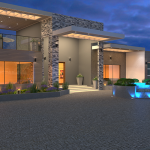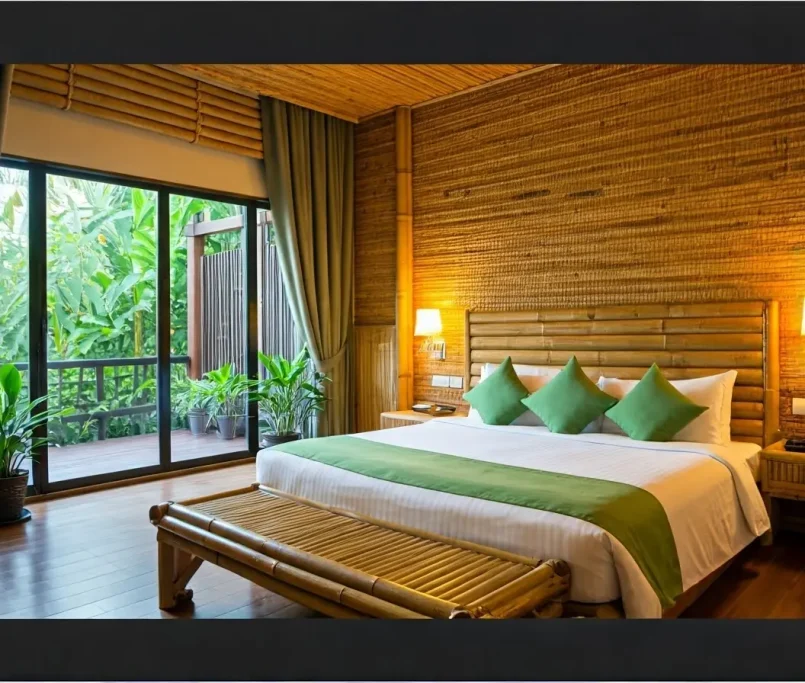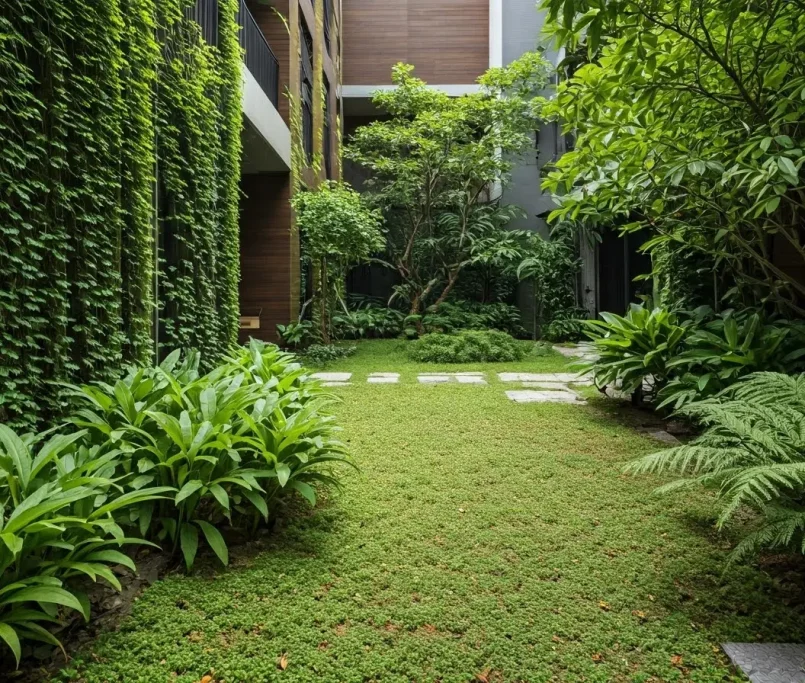Incorporating Water Features into Your Residential Landscaping: Tips and Benefits
Introduction to Water Features in Residential Landscaping
Water features can transform your backyard into a tranquil retreat. Think of the soothing sound of water trickling down a fountain or the serene view of a koi pond. It’s not just about the aesthetics; adding water features to your landscaping can also increase your property value and provide a calming atmosphere to unwind in. From simple bird baths to elaborate waterfalls, there’s a wide range of options to suit different tastes and budgets. Water features are more than just decorative elements; they can become the focal point of your garden, attracting wildlife and creating a serene outdoor living space. Whether you’re considering a small fountain to add a touch of elegance or a pond to bring a sense of nature closer to home, incorporating water into your landscape design can make a significant difference to the feel and ambiance of your outdoor area.
Top Reasons to Add Water Features to Your Garden
Adding water features to your garden isn’t just about making it look pretty, it’s about creating a space that feels alive and brings a sense of peace. First off, water features like fountains or ponds attract wildlife. Birds, butterflies, and even friendly frogs might come visit, turning your garden into a mini sanctuary. Another big reason is the soothing sound. The gentle sound of flowing water can drown out noise from the street, making your garden a calm retreat. Also, water features can actually increase your property value. They’re a sign of a well-thought-out landscape, appealing to potential buyers if you ever decide to sell. Lastly, they offer a visual focal point that can make your garden stand out. Just imagine the serene vibe of sitting by a water feature, surrounded by greenery. It’s like bringing the best parts of nature right to your doorstep.
Types of Water Features Suitable for Residential Landscaping
When thinking about adding water features to your yard, there are several types you can choose from, each bringing a unique vibe. First up, fountains are the go-to for many homeowners. They’re versatile, can fit in small or large spaces, and the sound of running water adds a peaceful ambiance to your outdoor area. Then there are ponds. Imagine having a small ecosystem in your backyard. Ponds can be home to fish, plants, and other wildlife, creating a natural retreat. For those who love the sound of flowing water but have less space, waterfalls are an excellent choice. They can be standalone or part of a pond, adding a dynamic element to your garden. Streams offer a meandering water feature that can make your garden feel like a wilderness escape. They’re perfect for larger properties and can be designed to look incredibly natural. Lastly, birdbaths are a simpler option but highly effective in attracting birds, adding life and movement to your garden. Each of these water features can elevate the look and feel of your outdoor space, turning it into a haven of relaxation and beauty.
Planning Considerations Before Installing a Water Feature
Before you jump into adding a water feature to your yard, there’s a bit to think about. First, check your budget. Water features can vary widely in cost, from simple, small fountains to large ponds or waterfalls. Knowing how much you’re willing to spend is crucial. Next, consider the space you have. Not every yard can fit a sprawling pond. Maybe a compact fountain or a bird bath is the way to go if you’re tight on space. You also need to think about maintenance. All water features need some upkeep, whether it’s cleaning out leaves or making sure pumps and filters are running right. Lastly, think about the vibe you’re aiming for. A modern, sleek fountain gives a different feel than a natural, rocky waterfall. Make sure whatever you choose fits with the overall look and feel of your garden.
DIY vs. Professional Installation: What to Choose?
Deciding between a DIY project and hiring a professional for installing a water feature boils down to a few key points. First, think about your skills. Do you enjoy hands-on projects? Are you good at following instructions and problem-solving? Then, DIY might be for you. Remember, YouTube and online forums are gold mines for tips and step-by-step guides. On the flip side, a big project might need tools and know-how that a professional brings to the table. They’ll nail it the first time, saving you the redo hassle. They also know the ins and outs of permits your project might need.
Cost-wise, DIY usually seems cheaper at first glance. You’re not paying for labor, after all. But, errors can add up, and sometimes buying tools you won’t use again doesn’t make sense. Hiring a pro, meanwhile, might seem pricier, but they come with their tools, skills, and typically a guarantee. So, weigh your patience, skill level, and budget. If you’re all about learning and hands-on work, dive into DIY. Love the idea more than the process? A professional’s probably your best bet.
How to Incorporate Water Features into Small Spaces
Fitting a water feature into a small garden or yard might seem like a tight squeeze, but it’s entirely doable with the right approach. First, think vertical. Wall-mounted fountains or a tall, slender water feature take up less ground space while still adding that soothing water sound. If you’re low on ground space, consider a tabletop water feature for a patio table or a small balcony. It’s about finding the right size that complements your space without overwhelming it. Second, go for multi-purpose water features. A small, shallow pond can serve as a home for aquatic plants and even a few fish, providing an eco-friendly pest control solution. Birdbaths are another fantastic option. They attract wildlife to your garden while serving the aesthetic purpose of a water feature. Lastly, always measure your available space meticulously before making any purchases. You want to ensure there’s enough room not just for the installation but also for maintenance access. By selecting the appropriate size and style, even the most diminutive outdoor area can enjoy the tranquility of a water feature.
Maintenance Tips for Your Water Feature
Maintaining your water feature is key to keeping it looking great and ensuring it lasts longer. Here are some straightforward tips to help you out. Firstly, always keep an eye on the water level. It can drop due to evaporation, especially in warmer months, so topping it off regularly is crucial. Secondly, keep the water clean. Leaves, twigs, and other debris not only look bad but can clog the system, leading to more serious issues. Skimming the water surface regularly and using a net for ponds can make a big difference. Also, pay attention to the water pump. This is the heart of your water feature. Clean it as recommended to prevent blockages and ensure it runs smoothly. Depending on your water feature type, you might also need to treat the water or even drain and clean the feature periodically to remove algae build-up and maintain water clarity. Finally, in colder climates, you’ll need to winterize your water feature to prevent damage from freezing temperatures. This might include draining it, removing the pump, and covering it to protect it during the off-season. Simple steps like these will help you enjoy your water feature for years to come without hassle.
Enhancing Your Water Feature with Lighting and Plant Life
Adding lights and plants to your water feature can turn your garden from just nice to extraordinary. Let’s dive into how you can use lighting and plant life to boost your water feature’s appeal. First off, lighting. Strategic lighting can make your water feature come alive at night, creating mesmerizing reflections and emphasizing its best features. Think about submersible lights for a glowing effect or spotlights to highlight the movement of water. LED lights are a great choice for energy efficiency and longevity. Next, consider the plant life around your water feature. Aquatic plants not only add a natural charm but also help keep the water clean and clear. Water lilies, lotus, and papyrus are popular choices that add color and texture. Don’t forget the surrounding area; ferns and moisture-loving plants can blur the edges between your water feature and the rest of the garden, making it all look seamless. With the right lights and plants, your water feature will not just be a part of your garden—it will be the star.
Water Features and Wildlife: Creating a Habitat in Your Garden
Adding a water feature to your garden isn’t just about creating a peaceful retreat for yourself. It’s also about offering a haven for local wildlife. From birds and bees to frogs and butterflies, water features can attract a variety of creatures, turning your garden into a bustling habitat. Birds might come to bathe and drink, while frogs could make it their home. Bees and butterflies, crucial for pollination, also seek out water on hot days. When planning your water feature, consider shallow edges for easy access and add native plants. These steps ensure you provide a safe and inviting space for wildlife, enhancing the natural ecosystem of your garden. Moreover, this interaction with nature can offer you a unique, up-close experience with wildlife, right in your own backyard.
Summary: Transforming Your Space with Water Features
Adding water features to your residential landscaping isn’t just about installing a fountain or a pond; it’s a transformative decision that can elevate your outdoor space to a new level of calm and aesthetic appeal. Think of it as bringing a piece of nature’s tranquility right into your backyard. Whether it’s the gentle sound of water flowing in a small fountain, the serene look of a backyard pond, or the modern vibe of a cascading waterfall, each water feature has its own unique way of enhancing the beauty and value of your home. Besides the obvious visual improvement, incorporating water features contributes to creating a more relaxing atmosphere. It’s like having your own retreat where you can unwind after a long day. Furthermore, water features can attract wildlife, like birds and butterflies, adding life and color to your garden. They also offer an excellent opportunity for customization, allowing you to integrate them seamlessly with other elements of your landscape design. From simple installations to elaborate designs, the addition of water features is a surefire way to turn your outdoor space into a personal oasis.












